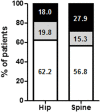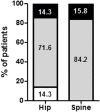Bone Mineral Density after Weight Gain in 160 Patients with Anorexia Nervosa
- PMID: 29034241
- PMCID: PMC5626930
- DOI: 10.3389/fnut.2017.00046
Bone Mineral Density after Weight Gain in 160 Patients with Anorexia Nervosa
Abstract
Low bone mineral density (BMD) is a frequent complication in anorexia nervosa (AN). There are controversial points of views regarding the restoration of bone mineralization after recovery in AN. We aimed to assess changes of BMD at 3 years in patients with AN and to explore the relationships between body composition, physical activity, and BMD. Patients with AN were included from 2009 to 2011 in a first visit (T0) with evaluation of weight, height, body mass index (BMI), body composition [fat mass (FM) and fat-free mass], and BMD. Those who had low BMD, either osteoporosis or osteopenia, were admitted in a second visit (T1) to carry out a new bone densitometry examination and body composition; they were also asked for their physical activity. At T0, our study involved 160 patients. Low BMD was observed in 53.6% of them and significant factors associated with demineralization were lower BMIs (16.5 ± 2.1 vs 17.3 ± 2.3 kg/m2, p = 0.01) and higher duration of AN (11.4 ± 10.5 vs 6.4 ± 6.5 years, p = 0.001). At 3 years follow-up (T1), 42 patients were involved and no significant changes in BMD were observed despite body weight increase (3.8 ± 6.1 kg). Interestingly, FM gain was a significant factor associated with BMD improvement at follow-up (8.0 ± 9.1 vs 3.0 ± 3.5 kg, p = 0.02). Our findings suggest that the restoration of normal bone values is not related to the increase of body weight, at least after 3 years. FM seems to play an important role in the pathophysiological mechanism of osteoporosis and osteopenia in AN.
Keywords: anorexia nervosa; body composition; bone mineral density; fat mass; osteoporosis.
Figures



Similar articles
-
Bone mineral density in anorexia nervosa: Only weight and menses recovery?Endocrinol Nutr. 2016 Nov;63(9):458-465. doi: 10.1016/j.endonu.2016.06.006. Epub 2016 Aug 6. Endocrinol Nutr. 2016. PMID: 27507610 English, Spanish.
-
Aged-Related Changes in Body Composition and Association between Body Composition with Bone Mass Density by Body Mass Index in Chinese Han Men over 50-year-old.PLoS One. 2015 Jun 19;10(6):e0130400. doi: 10.1371/journal.pone.0130400. eCollection 2015. PLoS One. 2015. PMID: 26090818 Free PMC article.
-
Factors influencing changes in bone mineral density in patients with anorexia nervosa-related osteoporosis: the effect of hormone replacement therapy.Calcif Tissue Int. 2008 Nov;83(5):315-23. doi: 10.1007/s00223-008-9173-y. Epub 2008 Oct 4. Calcif Tissue Int. 2008. PMID: 18836675
-
[Osteoporosis in anorexia nervosa: a literature review].Psychiatr Pol. 1999 Nov-Dec;33(6):887-96. Psychiatr Pol. 1999. PMID: 10776025 Review. Polish.
-
Bone mineralization disorders as a complication of anorexia nervosa - etiology, prevalence, course and treatment.Psychiatr Pol. 2016;50(3):509-20. doi: 10.12740/PP/59289. Psychiatr Pol. 2016. PMID: 27556110 Review. English, Polish.
Cited by
-
Bioelectrical Impedance Vector Analysis, Nutritional Ultrasound®, and Handgrip Strength as Innovative Methods for Monitoring Critical Anorexia Nervosa Physical Recovery: A Pilot Study.Nutrients. 2024 May 20;16(10):1539. doi: 10.3390/nu16101539. Nutrients. 2024. PMID: 38794777 Free PMC article.
-
Assessment of the frequency of hormonal disorders of the gonads and bone mineral density among women treated for anorexia nervosa in adolescence.Pediatr Endocrinol Diabetes Metab. 2022;28(1):16-22. doi: 10.5114/pedm.2022.112866. Pediatr Endocrinol Diabetes Metab. 2022. PMID: 35112559 Free PMC article.
-
Absence of relationships between depression and anxiety and bone mineral density in patients hospitalized for severe anorexia nervosa.Eat Weight Disord. 2021 Aug;26(6):1975-1984. doi: 10.1007/s40519-020-01045-9. Epub 2020 Oct 21. Eat Weight Disord. 2021. PMID: 33085062
References
LinkOut - more resources
Full Text Sources
Other Literature Sources

